Hangzhou’s West Lake area poses a perfect antidote to the urban tumult of eastern China. There is so much to see in and around Shanghai, that it is easy to become numbed by the maelstrom of the urban swell that is modern China. But a few hours away is a place of history and peace.
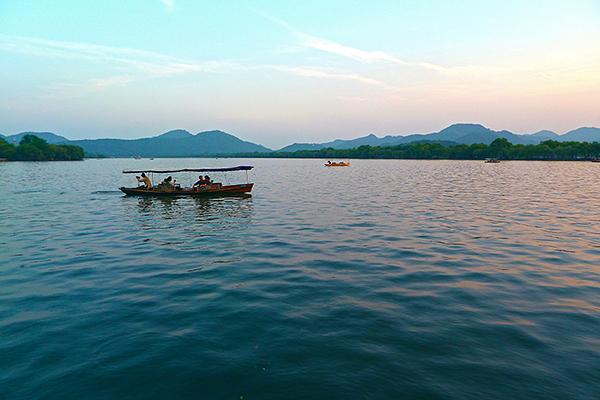
Sunset over Hangzhou’s West Lake (Photo: Paul Stafford)
Travel fatigue is a little bit like dehydration: by the time you notice it, you’ve already had it for a while. So it was with a fair bit of concern that I found myself in a Shanghai hostel dorm, desperately looking for a good escape.
The noise and the pollution and the droves of people at every turn – trappings of all major developing cities – were taking their toll. But it was the tedium of the other guys in the dorm, who seemed to have only travelled to Shanghai to go clubbing and meet ‘easy’ Chinese girls, which brought the fatigue to light more than anything else. Their whole purpose for travel seemed so base and uncultured, and Shanghai, as remarkable as it can be, was just another big city offering too much of the same.
The next morning I was taking the five hour train journey to Hangzhou. Even though Hangzhou has a population of seven million people, this felt like a rural escapade compared to the 24 million of the shining economic metropolis, Shanghai.
Either side of the train, villages, towns and fields rolled out to the horizon. There seemed to be no spot of land that human hands hadn’t transformed or tilled. There was hardly a break in the settlements, as though suburbia and rural land had been forced to combine forces. Wherever you looked, there were houses and electricity pylons.
I was born and raised in a small town in northern England. Our house was right on the edge of town, with fields on one side, and a peaceful residential street on the other. While I love the maelstrom of a happening city, a little piece of me always craves green, natural space. This feeling was magnified even further by eastern China, but with only two days to spare before heading back home to Seoul, South Korea – population: 18 million – my possibilities of having a view without a building, away from people, were slimming.
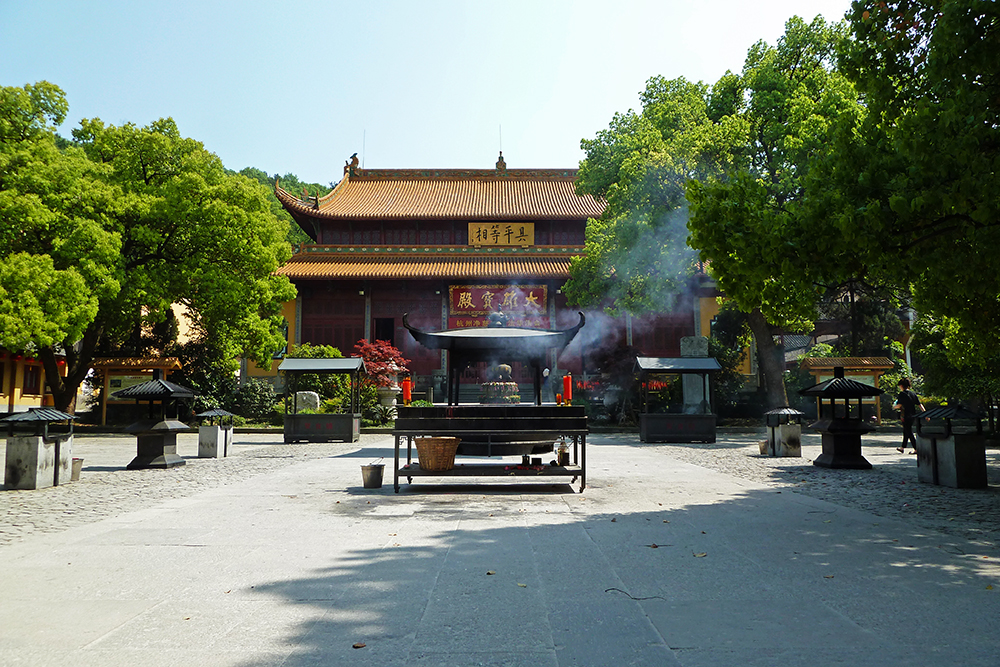
Incense burns outside a temple in Hangzhou (Photo: Paul Stafford)
Marco Polo’s Favourite Chinese City
Hangzhou seemed like the best choice because of its West Lake – the object of praise for generations of poets – and its surrounding imperial pleasure gardens. I’d heard of forested hills spilling from the west down to the lakeshore and some of China’s oldest and best-preserved temples. But at the train station, the same crush of people suggested I wasn’t the only one hoping for solitude.
After queuing just to get out of the station, I was crammed onto a cramped bus ride downtown, standing room only. Soon however, my face smushed up to the window, I saw the canals and water channels appear. They ran right across the city, once important for irrigation and transport, all the way back towards Shanghai.
Perhaps it was these canals that reminded Marco Polo so much of his Venetian home and prompted him to return many times; Hangzhou was his favourite city in China. But they were a welcome sight. They broke up the urbanity with ribbons of blue, fringed with the soft greens of weeping willows and beds of daisies that gleamed in the sun. I imagined Polo found solace and peace here in Hangzhou, seven centuries ago.
Determined to escape the crowds I found a hotel by the lake and hired a bike. On this east side, the popularity of the lake was keenly felt. A number of wedding parties were having their photos taken on a little stone bridge, with a great bronze water buffalo statue erupting from the water close by.
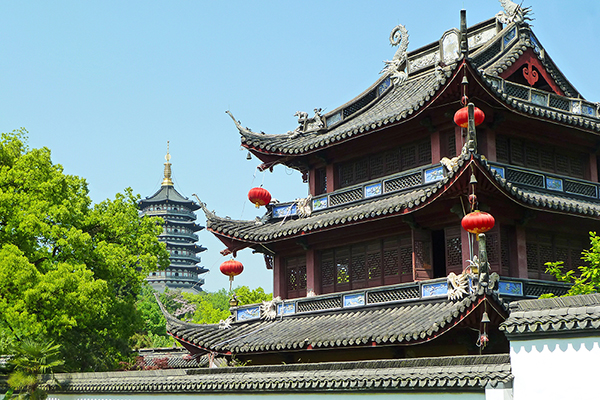
Nanping evening bell tower with Leiping Pagoda behind (Photo: Paul Stafford)
Historic Hangzhou
Cycling was tough going with so many people and I eventually dismounted and pushed the bike along until I reached Leifeng Pagoda, south of the lake. Waves of incense smoke rippled through the leaves. This was the start of a historic series of buildings and temples that may have existed in one form another since before Marco Polo’s days.
Leifeng dates back to the 10th century CE but its current version was redolent of modern China on the inside, with escalators dissolving much of the mystique of its ancient origins. It was far more pleasant to wander through the surrounding grounds, peeking into solemn temples here and there, or watching the devout go about their prostrations before the Buddha.
It took me a while to realize that the city was now on mute. The day-to-day of temple life had taken over. The sounds of a chanted prayer drifted out from a building I couldn’t quite see. It was the beginnings of something more peaceful as the fabricated city gave way to natural forest and hills further south west.
I decided to cycle away from the lake down Hupao Valley and into the green expanse. For a moment, the city was left behind and the whole atmosphere changed. It felt more tranquil. Apart from the occasional tour bus, the roads were relatively empty.
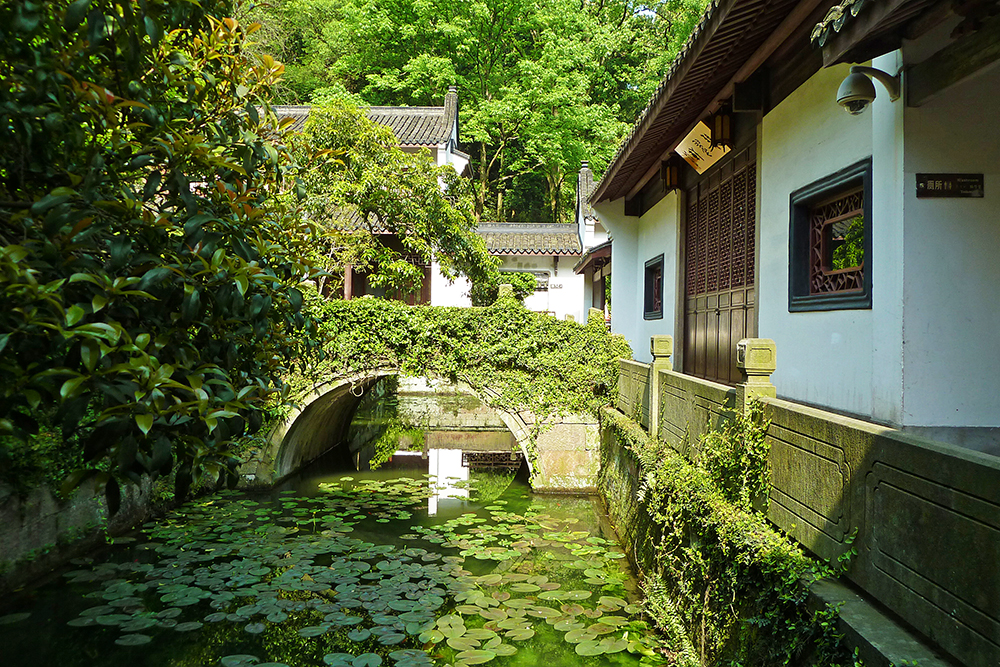
Serenity at Dreaming of Tiger Spring (Photo: Paul Stafford)
Springing Tiger
A sign announced ‘Dreaming of Tiger Spring,’ which seemed hard to resist. I chained up my bike and started to ascend the steps. Taking a little detour away from the main path, I found the serenity I’d hoped for. It may have looked like I’d stumbled upon a swamp, and that’s because I had, but with the mottled sun pattering the water as it pierced through the canopy I felt a deep sense of peace.
Up the hill was Tiger Spring and a small monastery. A young monk stood on the wooden veranda of a traditional Chinese building with hexagonal windows, looking at the tourists taking photos with a faded tiger statue that had seen better days. The water from this spring is supposed to be some of the best mineral water in China.
It was around here that JiGong, a Chinese monk famed for being both kind and eccentric, was buried. He had originally been exiled from the temple for drunkenness but was posthumously idolized, after being recognized as an important arhat (somebody who has attained nirvana) reincarnate. It is believed that those who reach nirvana, or indeed enlightenment, are reincarnated as monks again, and retain all their knowledge and learning from past lives.
Although not a believer myself, I imagined that the tranquil temple, with its circular doorways and coy ponds, set beside a natural spring, was as good a place as any to seek enlightenment. The tiger may have been fake, but my inner peace felt very real.
Descending from Dreaming of Tiger Spring, I hooked back up towards the north, parallel to the west shore of the lake, through the hills. Tea plantations lined the fields up towards Lingyin Temple and Feilai peak. By now it was late afternoon and although I was back on the tourist path, there were not so many people around.
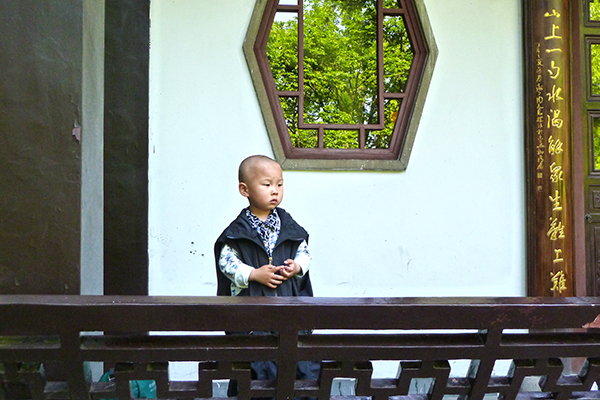
A Young Monk at Dreaming of Tiger Spring (Photo: Paul Stafford)
Flying From Afar
Lingyin’s scenic area was spread through the forest up the slopes of Feilai (aka Peak Flying From Afar). As with much of the region, the true history is lost in the wash of spiritual fervour and local fable, but it is believed that Indian monk Hui Li brought Buddhism here in 328CE, making it one of the oldest seats of Buddhism in eastern China.
I decided to climb the peak here that Hui Li had supposedly climbed and named. All around the lower reaches were nooks and grottos dug into the limestone. Many of them dated back to the 13th and 14th centuries, but the carvings remained in an excellent state of care.
One carving depicted a fat, reclining Buddha in an excellent state of humour, surrounded by his minions. Another depicted a bodhisattva carrying a flag and riding on the back of a lion. Avoiding the main path I found a slimmer, overgrown path pushing to the top of the mountain. At the top, a small clearing in the trees showed the lush undulations of other peaks becoming slowly lost in the evening’s haze. That has always been my own form of meditation: hiking in solitude.
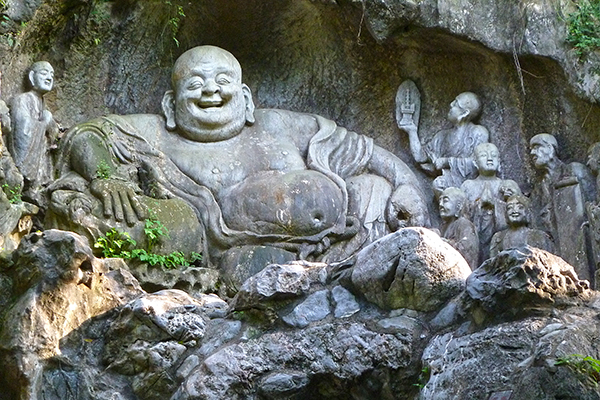
A Happy Buddha Carving at LingYin Caves (Photo: Paul Stafford)
Sunset was approaching and I hoped to watch it unfold over the lake. I cycled back towards the city as fast as I could, before detouring across a stone bridge onto Gushan Island. A thin causeway stretched from the island back to the main city.
Canopied pleasure boats drifted slowly by, the low hills behind them framing the magenta sky. I looked back east, towards the manmade skyline, pierced by cranes and covered in thick, dun smog that only China seems able to perfect.
Away to the south, lights illuminated Leifeng Pagoda, and music from a fountain laser show drifted across the water. I might have been about to re-enter the hubbub of modern civilization once more, but I’d had my fix of tranquillity and Hangzhou had certainly cured my travel fatigue.

Hangzhou’s West Lake at sunset (Photo: Paul Stafford)
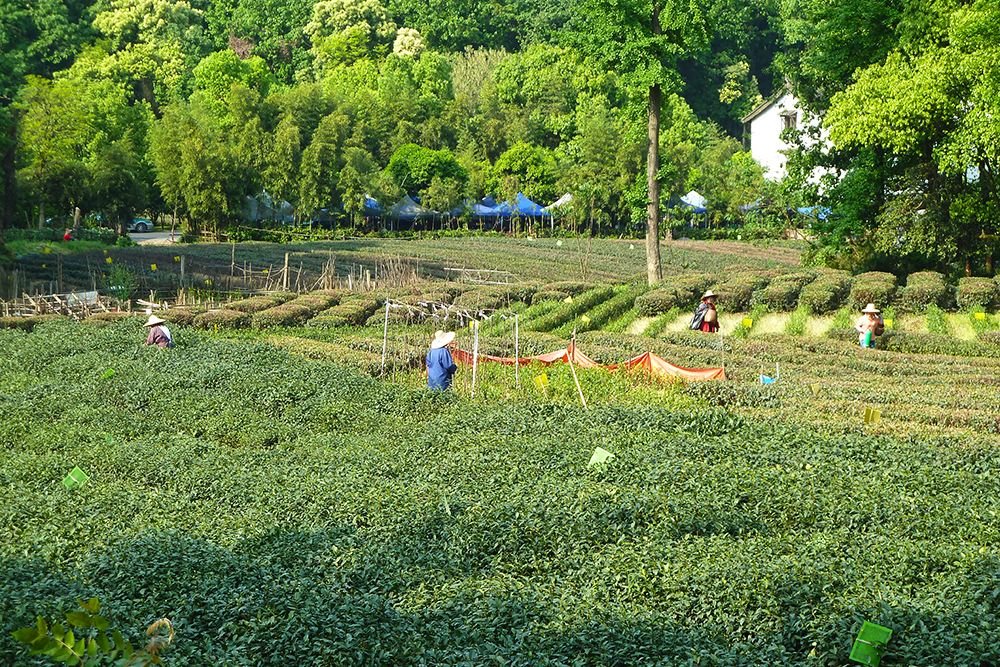
Tea Farmers work the fields near Hangzhou (Photo: Paul Stafford)